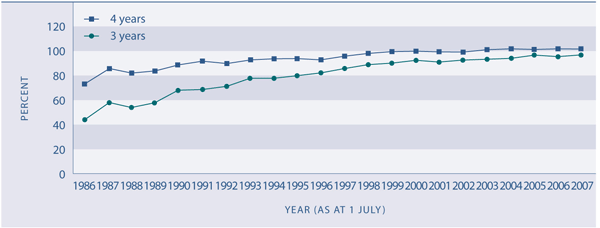Participation in early childhood education
Definition
The number of enrolments of children aged 3 and 4 years in early
childhood centres or home-based education programmes as a proportion of
all 3 and 4 year olds.
The measure includes all forms of organised and sustained centre and
home-based programmes designed to foster learning and emotional and
social development in children. The measure overestimates participation
because children enrolled in more than one early childhood centre will
be double-counted. Information from an alternative measure which avoids
double counting – the proportion of Year 1 students who participated in
early childhood education – is also included.
Relevance
Evidence from New Zealand and international research shows
that the early childhood years are vital to a child’s development and
their future ability to learn.48 Quality early childhood
programmes prepare young children socially, physically and academically
for entry into primary education and can help narrow the achievement
gap between children from low-income families and those from more
advantaged families.
Current level and trends
As at 1 July 2007, the "apparent" early childhood education
participation rate was 97 percent for 3 year olds and 102 percent for 4
year olds, confirming that some children attend more than one service.
These figures represent a substantial increase from 43 percent and 73
percent respectively in 1986. Much of the growth in participation in
early childhood education occurred in the five years between 1986 and
1991. Between 1997 and 2007, the participation of 3 year olds increased
by 11.3 percentage points and by 5.7 percentage points for 4 year olds.
Figure K1.1 Early childhood education
apparent participation rate, 3 and 4 year olds, 1986–2007

Source: Ministry of Education; Ministry of
Social Development
Note: These figures overestimate the true participation rate. Rates in
excess of 100 percent are possible because children can be enrolled in
more than one service
Sex differences
Participation in early childhood education does not appear to
vary by sex: boys make up just over half (51 percent) of all enrolments
of children aged 3 and 4 years, the same proportion as in the
population.
Participation by type of service
In 2007, childcare centres (44 percent) and kindergartens (37
percent) had the largest number of enrolments of 3 and 4 year olds in
early childhood education.
Much smaller numbers of children were enrolled in playcentres
(5 percent) and kōhanga reo (4 percent).
Prior participation by Year 1 students
The prior participation rate is an alternative measure that
avoids double counting.
The percentage of new school entrants who have previously
participated in early childhood education services has increased over
the last seven years, from 91 percent in July 2000 to 95 percent in
July 2007.
Ethnic differences
New Zealand European children are the most likely to have
attended an early childhood education service before entering primary
school: 98 percent compared with 96 percent of Asian, 91 percent of
Māori and 84 percent of Pacific Year 1 students in 2007. From 2000 to
2004, the prior participation rate for both Māori and Pacific new
entrants increased faster than the rate for New Zealand European new
entrants, narrowing the difference between these groups. However, since
2004, the growth in the rate for Māori has slowed, and there has been a
slight decline in the proportion of Pacific new entrants who had
attended early childhood education services before starting school.
Table K1.1 Early childhood education
attendance (%) by Year 1 students, by ethnic group, as at 1 July
2000–2007
| |
European |
Māori |
Pacific peoples
|
Asian |
Other |
Total |
| 2000 |
95.4 |
84.8 |
76.1 |
89.2 |
83.0 |
91.0 |
| 2001 |
96.0 |
85.3 |
76.3 |
89.8 |
84.1 |
91.4 |
| 2002 |
96.6 |
86.5 |
79.4 |
92.1 |
86.6 |
92.3 |
| 2003 |
97.4 |
88.4 |
83.4 |
92.4 |
88.9 |
93.6 |
| 2004 |
97.6 |
89.3 |
84.7 |
94.1 |
89.4 |
94.1 |
| 2005 |
97.7 |
89.9 |
84.5 |
95.1 |
89.9 |
94.3 |
| 2006 |
98.0 |
89.9 |
84.2 |
96.0 |
91.7 |
94.5 |
| 2007 |
98.2 |
90.6 |
84.0 |
96.0 |
93.6 |
94.7 |
Source: Ministry of Education
Note: These figures exclude cases for which attendance was unknown
Socio-economic differences
Year 1 children in low decile schools (those that draw their
students from communities with the highest degree of socio-economic
disadvantage) are much less likely to have attended an early childhood
education service than children in high decile schools. In 2007, only
83 percent of new entrants in decile 1 schools had previously attended
early childhood education services, compared with 97 percent in decile
6 schools and 99 percent in decile 10 schools.
Regional differences
In 2007, prior participation in early childhood education was
highest in the Canterbury region (99 percent) and Otago (98 percent),
and lowest in Northland (91 percent), Auckland and Gisborne (both 92
percent). |

